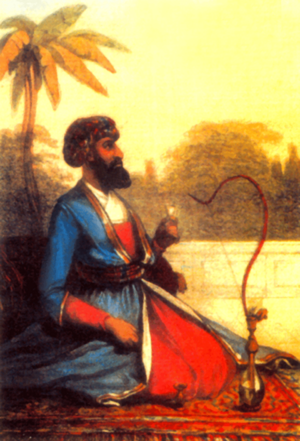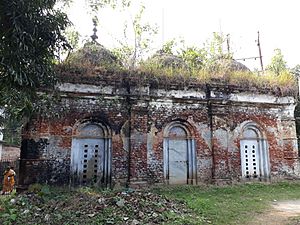I'tisam-ud-Din facts for kids
Quick facts for kids Shaikh Mirza Syed Muhammad I'tisam al-Din Panchnuri |
|
|---|---|

A portrait of the Mirza smoking hukka
|
|
| Religion | Islam |
| Denomination | Sunni |
| Personal | |
| Born | Syed Muhammad I'tisam al-Din 1730 Panchnur, Nadia, Bengal Subah, Mughal Empire |
| Died | 1800 (aged 69–70) Panchnur, Nadia, Bengal Subah, Mughal Empire |
| Senior posting | |
| Period in office | 18th century |
| Religious career | |
| Post | Munshi |
Mirza Muhammad I'tisam al-Din Panchnuri (also known as Itesham Uddin) was an important person from Bengal. He worked as a diplomat for the Mughal Empire. He was also the first educated person from South Asia to travel to Europe. This big trip happened in 1765.
Mirza I'tisam al-Din also worked as a munshi (a type of secretary or writer). He served both the Nawabs of Bengal and the British East India Company. He even wrote the official document for the 1765 Treaty of Allahabad, which was a major agreement.
Contents
Early Life and Family
Syed Muhammad I'tisam-ud-Din was born in 1730. His father was Sheikh Syed Taj-ud-Din. He was born near the Kazipara Masjid in his village. His family were respected Bengali Muslims called Syeds. They lived in the village of Panchnur, near the town of Chakdaha in the Nadia district. This area was part of the Mughal Empire's Bengal Subah at the time.
His family had moved to Bengal after fleeing the Mongol invasion of Persia and Mesopotamia. The old Kazipara Masjid where he was born is still standing today.
Education and Skills
I'tisam-ud-Din came from a well-off family. This meant he received a very good education. He could speak many languages fluently. These included Arabic, Bengali, Hindustani, and Persian language.
His older brother was a mufti (a religious scholar) and an adviser to the Nawab of Bengal, Alivardi Khan. Two other important people, Munshi Salimullah and Mirza Muhammad Qasim, helped train I'tisam. They taught him to become a munshi and improved his Persian language skills.
Career and Adventures
I'tisam al-Din started his career as a munshi for Mir Jafar in Murshidabad. Later, when Mir Qasim became the ruler, I'tisam joined the British East India Company. He worked for Major Martin Yorke and Major Mark. He even took part in a fight against Raja Asad uz-Zaman Khan. After this battle, Emperor Shah Alam II recognized his hard work.
Later, I'tisam worked for Captain Mackinon. He helped manage money for an orphanage. He also fought alongside Mackinon against Mir Qasim in 1763. These battles included the Battle of Giria and the Battle of Udhwa Nala. He was also made a Tehsildar (a local tax collector) of Kutubpur.
Journey to Europe
In 1765, Mirza I'tisam al-Din started working for John Carnac. He met Emperor Shah Alam again. He helped Colonel Carnac in a battle. After this, Emperor Shah Alam II offered I'tisam the title of Mirza. He also offered him a job as a munshi and a chance to travel to Europe.
He set off from Murshidabad with Captain Archibald Swinton. Their mission was to deliver a letter from Shah Alam II and a large sum of money to King George III in England. I'tisam also had his servant, Muhammad Muqim, with him.
After three weeks at sea, Swinton told I'tisam that the letter and money were not on the ship. Robert Clive had taken them! Clive later sent the money to the English king himself. This was to stop direct contact between England and the Mughal Empire. Because of this, I'tisam never met King George III.
Instead, he traveled with Swinton to Nantes in France. They sailed past Mauritius, Madagascar, the Cape of Good Hope, and Ascension Island. In Nantes, Swinton went to England. I'tisam stayed in France for a month, traveling to Calais.
From Calais, I'tisam took a ship to Dover. He arrived in Britain in 1766. He stayed in London for three months. Then, he met Swinton again in Oxford. There, they helped Sir William Jones with South Asian books. They translated a Persian book called Farhang-i-Jahangiri into English. I'tisam also taught Persian to people who planned to work in the Mughal Empire.
Returning Home
After three years, he returned to Bengal. Later, the British East India Company hired him again. This time, he helped with talks with the Maratha Empire. He traveled with John Hamilton to Pune. He helped write treaties and make peace. Local people called him Bilayet Munshi because he was the first to travel to what they called the Vilayet (Europe).
In 1785, he wrote a book called Shigurf-nama-i-Wilayat. This means 'Wonder Book of England'. It was written in Persian. The book described his travels. He was the first educated South Asian to visit England and write about his journey. His book has been translated into English, Hindustani, and Bengali.
Written Works
- Treaty of Allahabad (He wrote the text for this important agreement)
- Shigurf Namah i Vilayat (Excellent intelligence concerning Europe)
- "The wonders of Vilayet : being the memoir, originally in Persian, of a visit to France and Britain by Mirza Sheikh Iʼtesamuddin, an eighteenth century Indian gentleman"
- "Shigurf namah i velaët, or, Excellent intelligence concerning Europe : being the travels of Mirza Itesa Modeen, in Great Britain and France"
- Nasab Namah (This was his family tree)
Later Life and Death
Mirza I'tisam al-Din is thought to have passed away in the year 1800.
See also
- Aftab Ali
- Ayub Ali Master
- British Bangladeshi
- Shah Abdul Majid Qureshi


